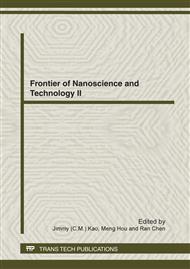p.245
p.249
p.254
p.259
p.263
p.267
p.272
p.277
p.281
Timoshenko Beam Model for Buckling of Nanowires with High-Order Surface Stresses Effects
Abstract:
High-order surface effects can have a significant effect in the mechanical behavior of micro- and nano-sized materials and structures. In the literature the mathematical framework of surface/interface stresses are generally described by generalized Young-Laplace equations based on membrane theory. A refined model of surface stress, counting into surface stresses as well as surface moments, collectively referred to as high-order surface stress, was recently derived by the authors. This framework allows us to simulate the interface between two neighboring media which may have varying in-plane stress through the thickness of the thin membrane. To illustrate surface stress effects, we consider the critical force of axial buckling of nanowires by accounting various degrees of surface stresses. Using the refined Timoshenko beam theory, we incorporate the high-order surface effect in the simulation of axial buckling of nanowires. The results are compared with the solutions based on conventional surface stress model as well as existing experimental data. This study might be helpful to characterize the mechanical properties of nanowires in a wide range of applications.
Info:
Periodical:
Pages:
281-284
Citation:
Online since:
June 2012
Authors:
Keywords:
Price:
Сopyright:
© 2012 Trans Tech Publications Ltd. All Rights Reserved
Share:
Citation:


